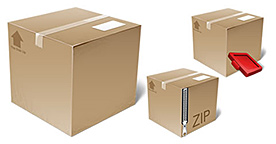|
Take the extra time to package your shipment correctly, this is your greatest insurance against damage. Contact your Freight Agent at FreightForwarding.com who is there to help in this process.
LABELING
A shipment that is properly addressed is the customer's greatest protection against non-delivery. For us to pick up your shipment, be sure you have clearly marked the name, address, and zip code of the consignee (the person who the shipment is going to) on each box or crate in felt tip marker or adhesive label. If there are additional special instructions such as: optional telephone numbers to contact upon arrival, or special hours of delivery, or persons to contact other that the consignee, please communicate to your Freight Agent so that we can communicate in writing those specific shipping instructions on the Bill of Lading. Contact your Freight Agent if you have any questions, we are here to help you.
CORRECT PACKAGING
A) Crating
This packaging method is usually used for larger heavier items or as the best guarantee against breakage as well as high valued items that could be damaged easily. There is usually a higher cost for this method of packaging, but the advantage is protection.
B) Double-Walled Corrugated Cardboard
This packaging method is often a reasonable alternative to crating and used quite often in the shipping industry. If moving furniture or other larger items, to ensure the protection of the finishes and delicate parts, use quality styrofoam and bubble wrap around these areas, box items securely so there is no movement inside, palletize and use strapping to hold in place, metal or nylon strapping bands are preferred.
C) Double-Boxing
This packaging method is used more often for fragile items such as: glassware, china, and smaller items that need extra care. These items should be separately hand wrapped in a commercial bubble wrap individually. Then these items are placed inside an inner shipping box with packaging peanuts, which will then go inside an actual shipping box with approximately 2-3 inches or more of packaging peanuts around all six sides of the inner shipping box.
D) Corrugated Cardboard (standard grade)
This is the method that is used for shipping clothes, books, plastic and other things that are not breakable. Consult with your Freight Agent to see if this is an acceptable alternative for your items.
E) Palletizing
This method is used for consolidating smaller items together, after they are boxed, and is necessary for large items and heavy shipments. This means the items are placed on a heavy wood foundation, shrink wrapped, strapped in place and moved with a special "pallet jack" that the truck driver would have upon pickups and deliveries. When using this method, a liftgate or dock is needed and forklift is used to move these items. There is generally an extra charge added for the liftgate service.
Contact your Freight Agent at FreightForwarding.com if you have any questions, we are here to help you.
|



